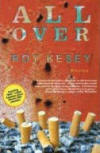All Over
Roy Kesey’s debut story collection, All Over, was also the groundbreaking ceremony for Dzanc Books, a new publishing house based in Michigan. Dzanc “was created in 2006 to advance great writing and champion those writers who don’t fit neatly into the marketing niches of for-profit presses.” Dzanc did well to procure talent like Kesey to launch their press.
Roy Kesey’s debut story collection, All Over, was also the groundbreaking ceremony for Dzanc Books, a new publishing house based in Michigan. Dzanc “was created in 2006 to advance great writing and champion those writers who don’t fit neatly into the marketing niches of for-profit presses.” Dzanc did well to procure talent like Kesey to launch their press.
Kesey’s collection has been anticipated by many who’ve been reading his stories in dozens of the highest quality literary magazines, and ever since his prizewinning novella Nothing in the World was published in 2006. In All Over, Kesey creates strange and wonderful worlds with pathos, sharp intelligence, and humor. While Kesey is definitely working in a tradition—names like Barth, Barthelme, and Saunders come to mind—these odd, attractive stories bear Kesey’s DNA.
The collection begins with one of the more traditional (realism in this case) stories in the bunch, “Invunche y voladora,” where a newlywed couple awakes on the first day of their honeymoon in Chile, still reeling from the ceremony and reception they rushed to plan and execute and now do not remember. They find themselves in a foreign place, learning that everything has changed and continues to evolve at a seemingly unnatural pace. And when their surroundings have suddenly organized into a situation, they once again have to make a quick decision that will affect their lives forever.
In “Instituto,” the main character, Stanley, is finally convinced that he requires the services of a mysterious company. The Instituto de Perfeccionamiento offers . . . well, the services are never stated specifically, only that the “program . . . has been chosen on your behalf . . . Cash, check, or credit card?” And after some circular linguistic games, he forks over one hundred bucks to begin his program. Treatment sessions involve sitting in a room for a little bit and then going home. But then Stanley wakes up the morning after to find that his “skin, hair, refrigerator, eyesight, wardrobe, gastrointestinal tract, sofa, car, unicycle, hearing, pogo-stick, flooring, plumbing, prostate, wiring, fingernails, and so on” are all miraculously, arbitrarily “perfected,” a word whose meaning never quite stays in one place throughout the story. Perfection, improvement, or whatever, he wants to know how this is done and is told that, “You are not meant to understand, sir. You are meant only to be pleased.” As soon as Stanley thought he was “just getting started, just getting going,” he is informed that his “program is complete.” So maybe he is left with the tools to pursue the things he didn’t know he really wanted most of all—none of which, of course, “yield to our treatment.” But maybe he simply finds himself drowning in more whetted desires than can possibly be fulfilled by his “perfect” things.
Kesey manages to do a lot with little. Most of the stories are a few pages or less but with his precise word economy they are thought provoking and entertaining. We find girls who work at Pizza Hut taking meticulous care to build a fairy tale castle out of material as fragile and perishable as the fantasies that nourished their hopes and desires as children. In “Fontanel” a verbal photo collage guides the reader through the artifacts of a miraculous event, which, just beneath the surfaces of things photographed, is a tragedy that can only be examined in small, tolerable pieces. “Martin” takes the shape of a psychological evaluation where the subject in question believes himself to be a guitar string, while the author of the evaluation unwittingly provides as much if not more insight into her own state of mind. The homeless narrator in “Strike” tells how the garbage men went on strike and he and his wife became the king and queen of New York City. Elsewhere, “Cheese” is a smart, fresh, funny riff on The Inquisition, which could have been tired rehash in less capable hands.
Roy Kesey is as innovative with form and content as any writer working today. Naming names like John Barth, Donald Barthelme, Robert Coover, Don Delillo, George Saunders, and Thomas Pynchon is helpful to readers who may be unfamiliar with his work, but from now on it will only require one name: Roy Kesey.





